most likely neutral; primarily fungivores; details of association with bees unknown
Tarsonemus Canestrini and Fanzago, 1876
Superorder Acariformes » Order Trombidiformes » Suborder Prostigmata » Infraorder Eleutherengona » Hyporder Heterostigmata » Family Tarsonemidae » Genus Tarsonemus
Chironemus minusculus Canestrini and Fanzago, 1876
Adult: Metapodosomal venter with 2 pairs of setae (3a, 3b; 3c, 4b absent) (Fig. 2). Cheliceral stylets short (Fig 2). Femurfemur:
Leg or palp segment (also known as podomere or palpomere) between genu and trochanter. In ParasitIformes can be subdivided into telofemur and basifemur.
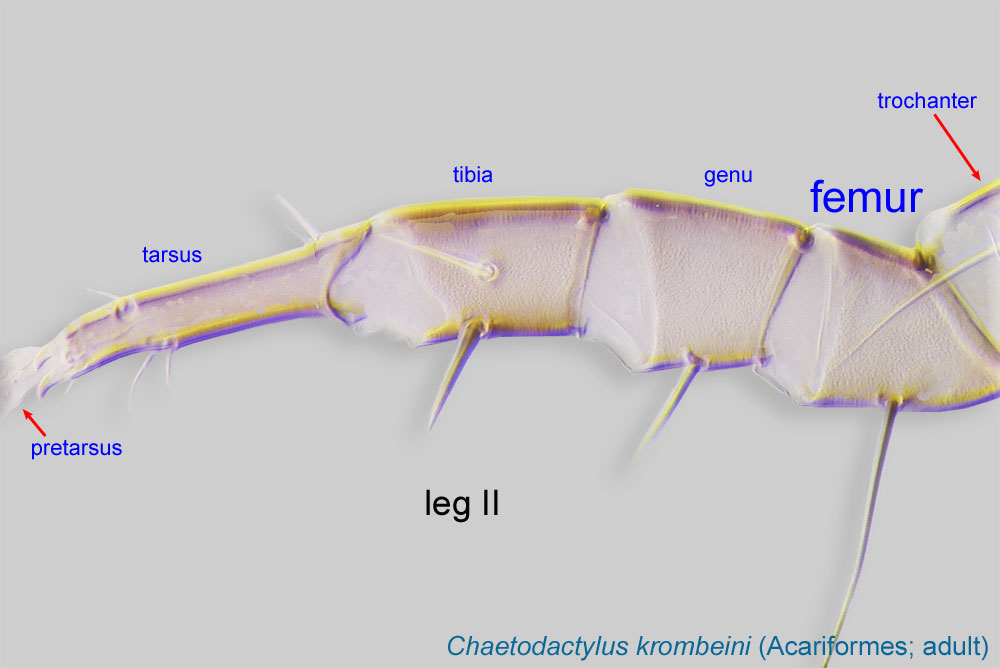 I with 3-4 setae, femurfemur:
I with 3-4 setae, femurfemur:
Leg or palp segment (also known as podomere or palpomere) between genu and trochanter. In ParasitIformes can be subdivided into telofemur and basifemur.
 II with 2-3 setae (Fig. 2). Dorsal gnathosomal setae filiform (Fig. 1). Dorsal setae of idiosomaidiosoma:
II with 2-3 setae (Fig. 2). Dorsal gnathosomal setae filiform (Fig. 1). Dorsal setae of idiosomaidiosoma:
Body not including the gnathosoma.
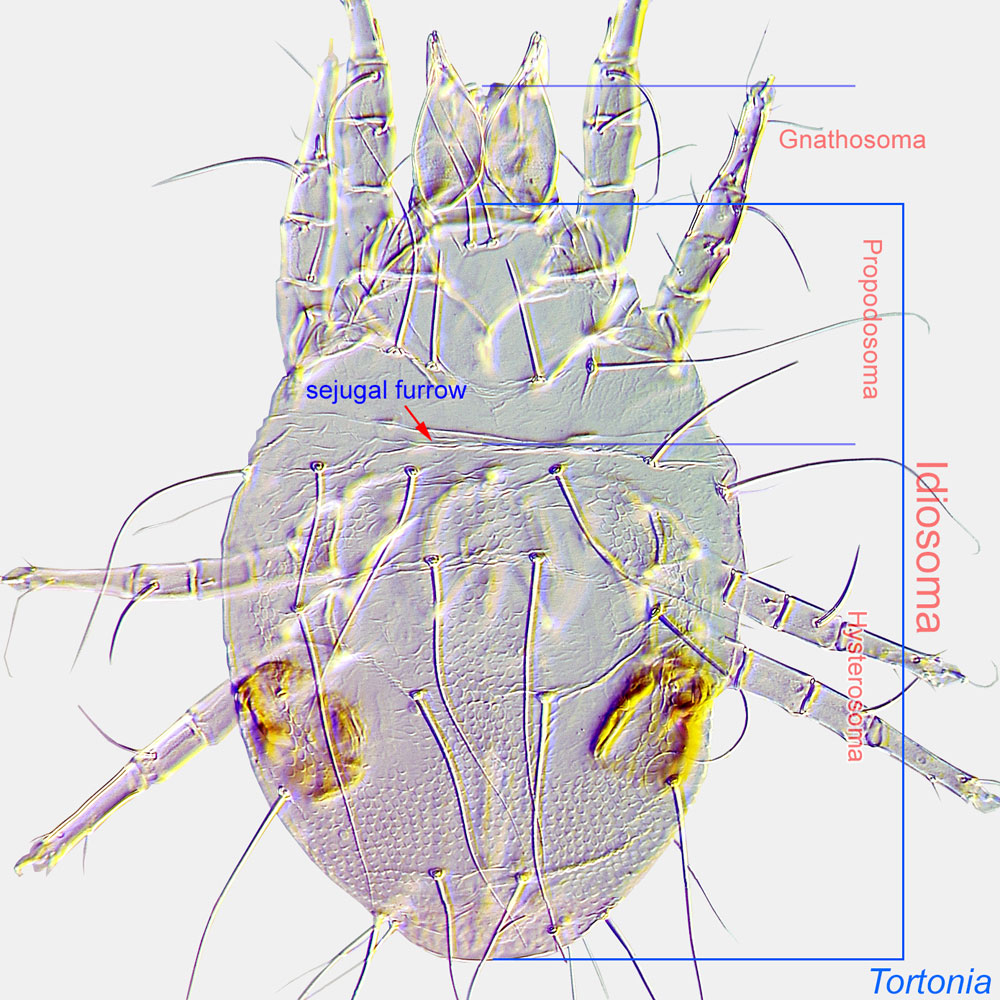 simple, unmodified (Fig. 1). Gnathosomal capsule not conspicuously beaklike (Fig 2).
simple, unmodified (Fig. 1). Gnathosomal capsule not conspicuously beaklike (Fig 2).
Female: Claw I present, not enlarged (Figs. 1, 3). Ambulacrumambulacrum:
The claws and empodium of the apotele or pretarsus.
I developed (Figs. 1, 3). Prodorsumprodorsum:
Dorsal surface of propodosoma.
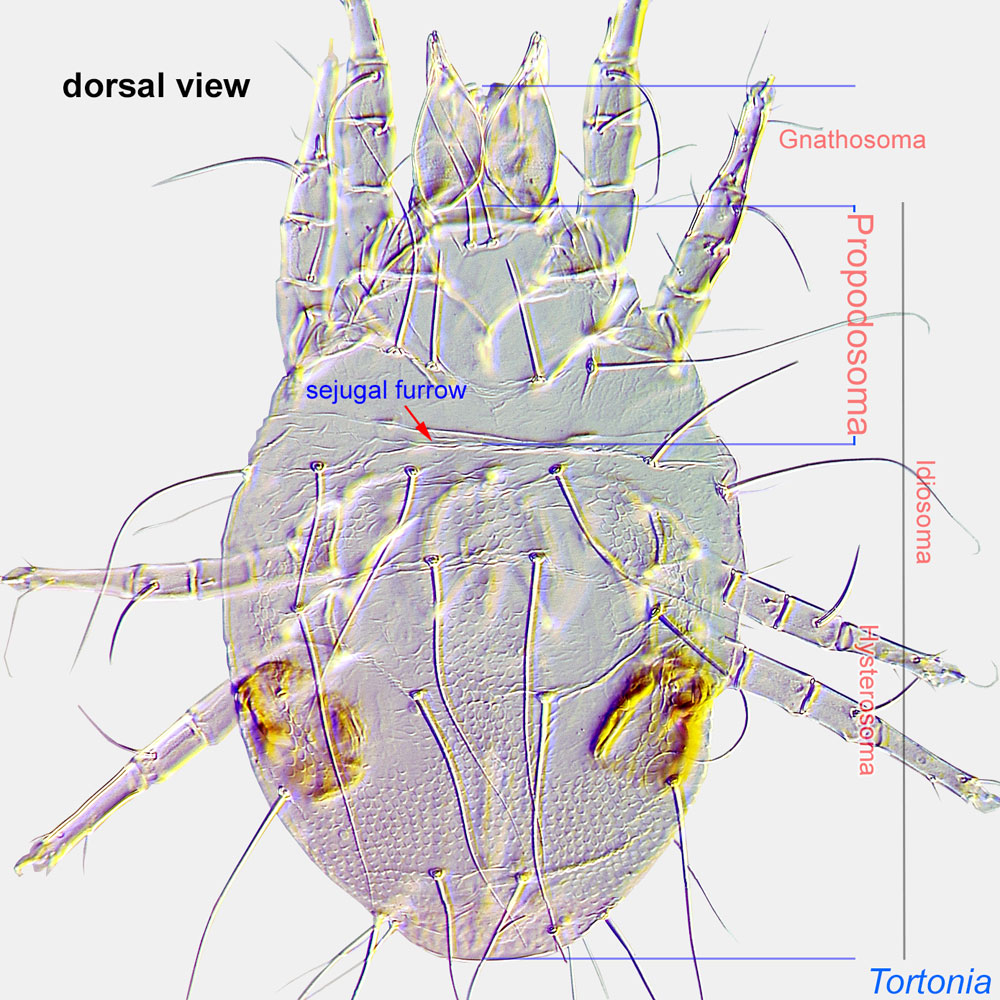 with a pair of capitate trichobothriatrichobothrium:
with a pair of capitate trichobothriatrichobothrium:
Modified seta that can be distinguished from true seta by its distinct large socket (complex cup-like cavity), and often, shape (which may be filiform, ciliate, pectinate, or thickened or clubbed). Present in many Acariformes (except Astigmata) and Opilioacarida (Parasitiformes). When paired and situated on the propodosoma, termed "prodorsal."
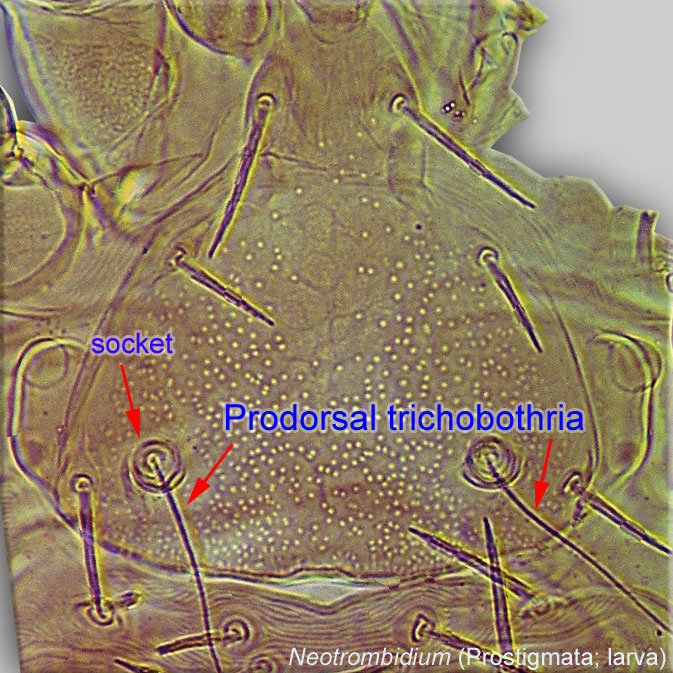 Figs. 1, 3). Tegulategula:
Figs. 1, 3). Tegulategula:
Lobe-like to acuminate cuticular plate projecting posteriorly between coxae IV in Tarsonemidae. Also used for hinged sclerite covering the wing bases in bees.
short, not elongated, rounded (Fig. 2). Pharynxpharynx:
A muscular ectodermal structure that opens into a buccal cavity or mouth, and serves as a suction pump for ingesting food materials. In certain Heterostigmata pharyngal musculature is subdivided into 2-3 distinct parts.
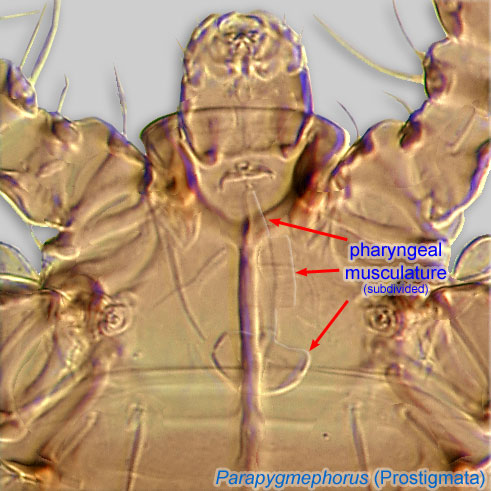 not conspicuously enlarged (Fig 2). Setae sc2 well posterior to stigma Figs. 1, 3). Prodorsalprodorsal:
not conspicuously enlarged (Fig 2). Setae sc2 well posterior to stigma Figs. 1, 3). Prodorsalprodorsal:
Pertaining to the prodorsum.
shield not extended hoodlike over gnathosomagnathosoma:
Division of body anterior to the propodosoma bearing two pairs of appendages (palps and chelicerae).
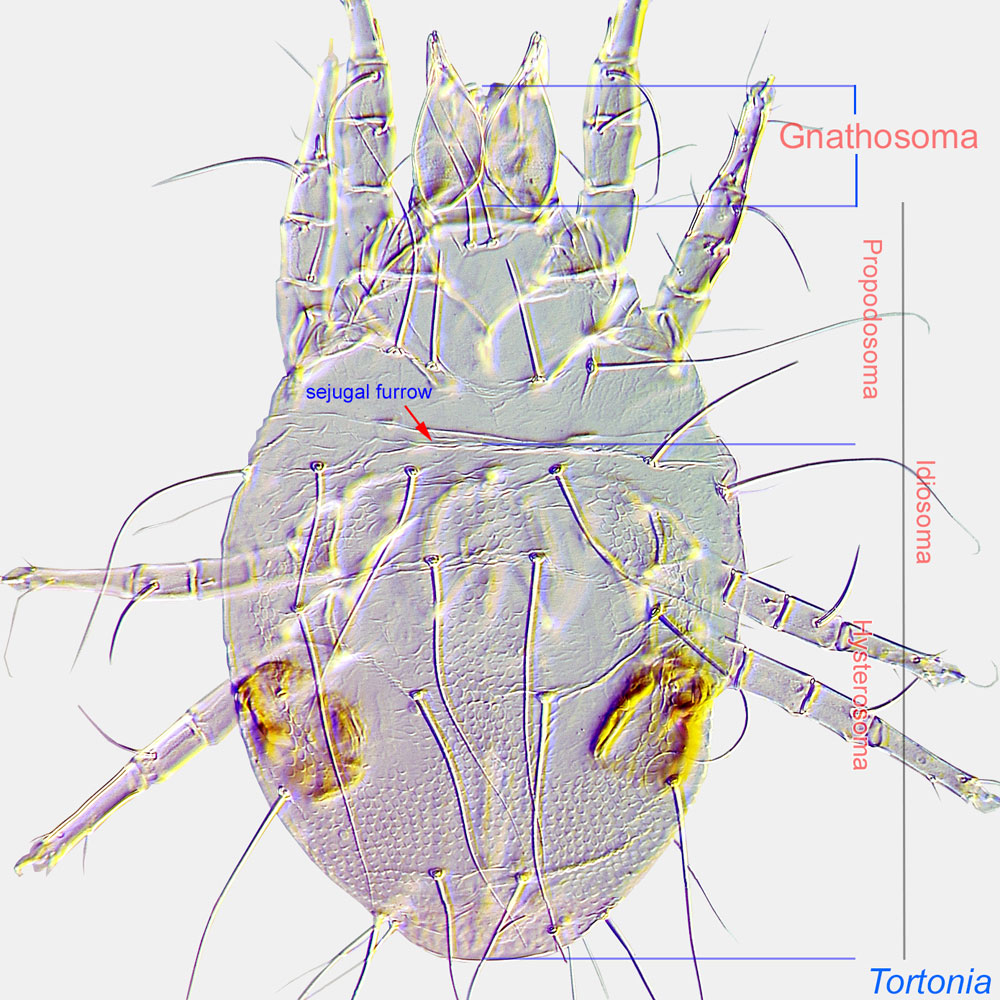 and not covering stigmata (Figs. 1, 3). No hornlike protuberances with stigmata Figs. 1, 3). ApodemesApodeme:
and not covering stigmata (Figs. 1, 3). No hornlike protuberances with stigmata Figs. 1, 3). ApodemesApodeme:
Internal sclerite that serves as an attachment site for muscles. Most commonly used (as "coxal apodeme") to describe elements of coxae fused to the ventral body in Acariformes (coxae are free and not fused to the body in Parasitiformes), and may be variously referred to as ventral, sternal, anterior, or posterior.
 4 not extending posterolaterally to bases of trochanterstrochanter:
4 not extending posterolaterally to bases of trochanterstrochanter:
Leg or palp segment (also known as podomere or palpomere) between femur and coxa. In Acariformes this is the most basal movable leg segment (or podomere) forming a joint with the body.
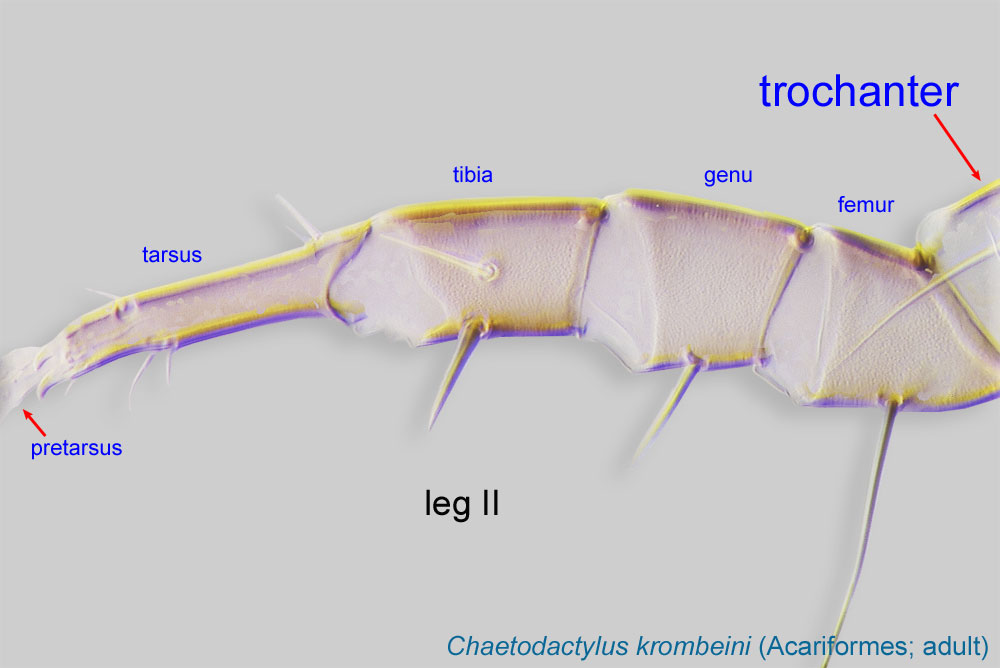 IV (Fig 2). Setae h not longer than any setae on tergites D and EF (Fig. 1). Leg IV clearly longer than tegulategula:
IV (Fig 2). Setae h not longer than any setae on tergites D and EF (Fig. 1). Leg IV clearly longer than tegulategula:
Lobe-like to acuminate cuticular plate projecting posteriorly between coxae IV in Tarsonemidae. Also used for hinged sclerite covering the wing bases in bees.
(Fig. 2). Sejugal apodemeapodeme:
Internal sclerite that serves as an attachment site for muscles. Most commonly used (as "coxal apodeme") to describe elements of coxae fused to the ventral body in Acariformes (coxae are free and not fused to the body in Parasitiformes), and may be variously referred to as ventral, sternal, anterior, or posterior.
 (apodeme delimiting propodosomapropodosoma:
(apodeme delimiting propodosomapropodosoma:
Anterior part of idiosoma, in front of sejugal furrow.
 and hystersoma ventrally) developed (Fig. 2).
and hystersoma ventrally) developed (Fig. 2).
This is a species-rich genus with nearly 200 described species. Five of these species are associated with bees. A key to all species is not available. Regional keys exist for the Palaearctic region (Kaliszewski, 1993Kaliszewski, 1993:
Kaliszewski, M. 1993. Key to the Palearctic of the genus Tarsonemus Acari, Tarsonemidae. Uniwersytet im Adama Mickiewicza w Poznaniu Seria Zoologia 14: 1-204.), Central Europe (Krczal, 1957Krczal, 1957:
Krczal, H. 1957. Sytstematik und Ökologie der Pyemotiden. In Sytstematik und Ökologie Mitteleuropäischer Acarina. 1(1). ed. H.-J. Stammer, 385-823. Leipzig: Akademissche Verlaggesellschaft.), the former USSR (Sevastyanov, 1978Sevastyanov, 1978:
Sevastyanov, V. D. 1978. [Cohort Tarsonemina]. In [Opredelitel' obytayshchikh v pochve kleshchey. Trombidiformes = Mesostigmata Identification key of soil inhabiting mites. Trombidiformes], ed. M. S. Gilyarov, 14-90. Moscow: Nauka.), and China (Lin and Zhang, 2006Lin and Zhang, 2006:
Lin, J.-Z. amp; Z.-Q. Zhang. 2006. A key to Tarsonemus females (Acari: Tarsonemidae) in China and description of a new species intercepted in New Zealand. Systematic and Applied Acarology 11: 181-193.).
See Pseudacarapis.
The genus is cosmopolitan; species associated with bees have been recorded from all zoogeographic regions but Afrotropical.
honey bees (Apis), bumble bees (Bombus), large carpenter bees (Xylocopa), and stingless bees of the genus Melipona
facultative facultative:
can complete entire life cycle without bees or their close relative, wasps
(generalist species)
permanent permanent:
associated exclusively with bees or their close relative, wasps; cannot live without these hosts
(Tarsonemus apis, T. platynopodae, and T. xylocopae)
Generalist species
Tarsonemus apis, T. platynopodae, and T. xylocopae:
Out of nearly 200 species of Tarsonemus, five species have been recorded in association with bees: Tarsonemus apis, T. blakemorei, T. fusarii, T. minimax, T. platynopodae, and T. xylocopae.
Among them, Tarsonemus fusarii is a widespread generalist primarily inhabiting stored grain. T. minimax is associated with bark beetles (so the records from bees may be accidental or the species was misidentified). Similarly, T. blakemorei was originally found in nests of birds but then was recorded from various bees in India: Apis mellifera, Apis cerana, and Melipona sp. (Sumangala and Haq, 2001Sumangala and Haq, 2001:
Sumangala, K. amp; M. A. Haq. 2001. Survey of the mite fauna associated with Apis spp. in Kerala, southern India. In Acarology: Proceedings of the 10th International Congress., eds. R. B. Halliday, D. E. Walter, H. C. Proctor, R. A. Norton amp; M. J. Colloff, 565-568. Melbourne: CSIRO Publishing.).
Three other species have been found exclusively on bees and/or their nests, indicating close associations: Tarsonemus apis (Apis mellifera), T. platynopodae (Xylocopa latipes, Malaysia), and T. xylocopae (Xylocopa frontalis). Tarsonemus apis has been collected from Apis mellifera (Europe) and other species of Apis in Singapore, both on adult bees and in stored pollen.
Mites of the genus Tarsonemus are common in a great variety of habitats including soil, litter, ground-level and subterranean nests of vertebrate and invertebrate animals, decaying wood, bracket fungi, subcorticalsubcortical:
Under tree bark.
habitats where they are associated with insects, stored grain and food products, laboratory cultures, house dust of man-made habitats, and on all sorts of woody and herbaceous plants including conifers, monocotyledonous plants, and especially dicotyledonous plants, both deciduous and evergreen.
Mites of this genus are primarily fungivores. A few species are economically important pests in commercial mushroom cultures and fungal cultures in research laboratories. Species of Tarsonemus sometimes carry fungal spores, mostly in the membranous lateral areas underneath the tergite. For example, Tarsonemus ips may play a role in its beetle host's (southern pine beetle) transmission of the bluestain fungus, Ceratocystis minor, to coniferous trees. Some species may be transitionally phytophagous, attacking plants of agricultural importance, such as crops and ornamentals. One species, T. dispar, associated with passalid beetles, feeds on living animal exudates or products. Other species of Tarsonemus appear to be beneficially important in their association with fungi in the decomposition of soil litter (reviewed in Lindquist, 1985Lindquist, 1985:
Lindquist, E. E. 1985. Discovery of sporothecae in adult female Trochometridium Cross, with notes on analogous structures in Siteroptes Amerling (Acari: Heterostigmata). Experimental and Applied Acarology . 1 : 73-85.).